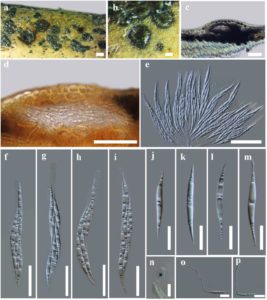Oxydothis rhapidicola Konta & K.D. Hyde, in Konta, Hongsanan, Tibpromma, Thongbai, Maharachchikumbura, Bahkali, Hyde & Boonmee, Mycosphere 7(9): 1438 (2016)
Index Fungorum number: IF 552538; Facesoffungi number: FoF 02706
Etymology – The specific epithet refers to the host genus Rhapis
Saprobic on petiole of Rhapis excelsa (Thunb.) Rehder (Arecaceae). Sexual morph: Ascomata 303–480 μm diam. (x̅ = 361 μm diam., n = 40, up to 600 μm), solitary or aggregated, mostly solitary when young, becoming grouped at maturity, immersed, comprising slightly raised blistering areas through the host tissue, axis oblique or perpendicular to the host surface, with central papilla, 25–44 μm high × 82–124 μm diam. (x̅ = 40 × 117 μm, n = 5), in transverse section, lenticular, globose to subglobose, darker at the central region, light towards the outer darker rim on the host surface. Peridium 10–14 (x̅ = 12 μm, n = 10), outer cells merging with the host epidermal cells, comprising dark brown to black, cells of textura angularis. Asci 103–150 × 8–12 μm (x̅ = 123 × 10 μm, n = 10), 8-spored, unitunicate, cylindrical, pedicellate, with a J+, wedge-shaped, subapical ring. Ascospores 47–50 × 3–5 μm (x̅ = 49 × 4 μm, n = 20), 2–4-seriate, fusiform, tapering gradually from the center to the ends, centrally 1-septate, not constricted at the septum, with pointed ends, hyaline, with large multi-guttules in each cell, sometimes smaller near the ends, smooth-walled. Asexual morph: Undetermined. Appressoria not formed.
Culture characteristics– Ascospores germinating on MEA within 24 hours and germ tubes produced from end cells. Colonies on MEA white, grey and olivaceous, rough on the surface, producing ascomata-like structures, hyphae, septate, branched, smooth-walled (Fig. 9 viz f).
Material examined– Thailand, Chiang Rai, on dead petiole of Rhapis excelsa (Arecaceae), 29 July 2014, S. Konta, DTCR03 (MFLU 15-0002, holotype); Ibid. (HKAS 95035, isotype); ex-type living culture, MFLUCC 14-0616.
Notes – Oxydothis rhapidicola is morphologically similar to O. asiatica J. Fröhl. & K.D. Hyde. and O. parvula (H. Syd. & P. Syd.) Petr. in ascomata and ascospore shape. Oxydothis rhapidicola however, differs from both species in having a single large guttule in each of the cells of the ascospores, with small guttules near each end, while O. asiatica and O. parvula lack these. Phylogenetic analyses indicate that O. rhapidicola is closely related to O. inaequalis with moderate support (66% ML, 0.94 PP), but O. rhapidicola differs from O. inaequalis in having 2–3-seriate ascospores in the asci, with a large guttules in each ascospore cell. Asci and ascospores are smaller than O. inaequalis.

Fig 1. Oxydothis rhapidicola (holotype) a. Ascomata on host substrate. b. Close up of ascomata. c–d. Sections of ascomata. f–i. Asci. j–m. Ascospores. n. J+ reaction of apical ring. o–p. Germinating ascospores. Scale bars: a = 500 μm, b = 100 μm, c–e = 50 μm, f–i = 20 μm, j–m = 10 μm, n = 5 μm, o–p = 20 μm.
